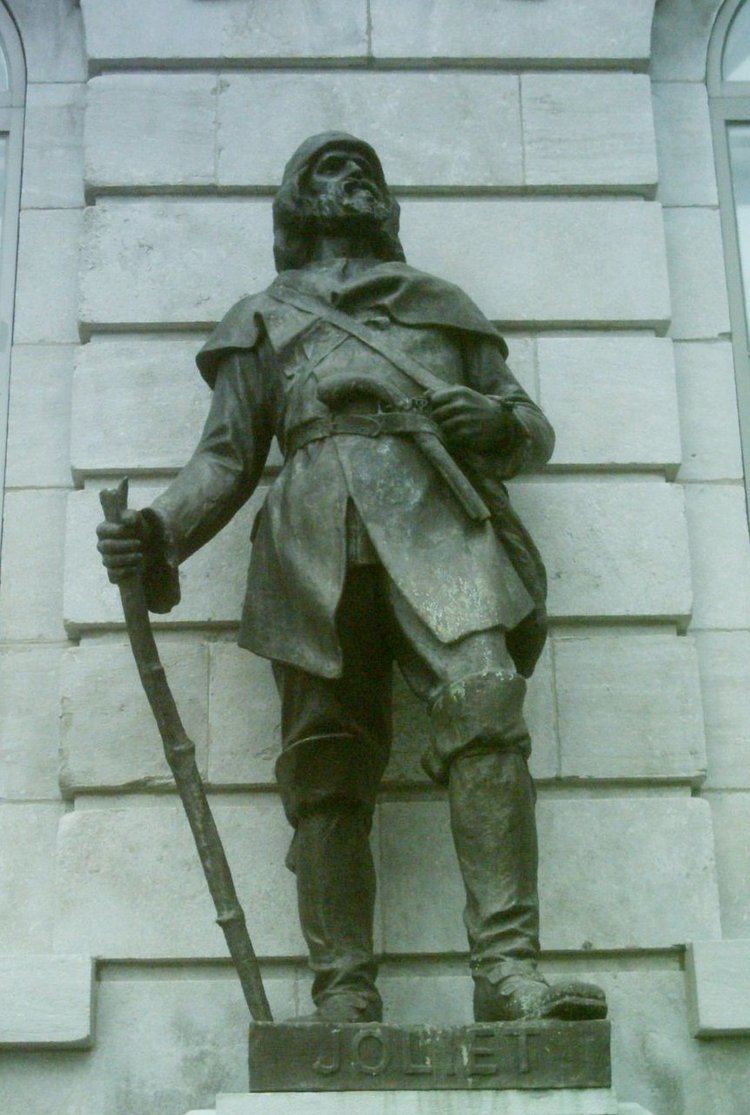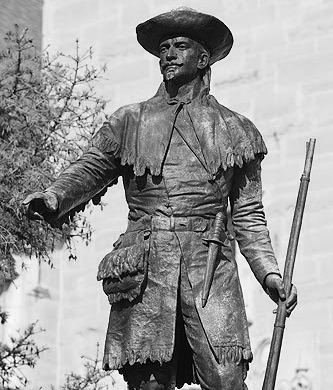Allegiance New France (Canada) Name Louis Jolliet Signature | Relations Jacque Jolliet: Father Nationality Canadian | |
 | ||
Awards Jolliet was granted land south of Quebec in return for his favours Died 1700, Anticosti Island, Canada Similar People Jacques Marquette, Rene‑Robert Cavelier - Sieur de, Samuel de Champlain, Henry Hudson | ||
Jacques marquette and louis jolliet
Louis Jolliet (September 21, 1645 – last seen May 1700) was a French Canadian explorer known for his discoveries in North America. Jolliet and Jesuit Father Jacques Marquette, a Catholic priest and missionary, were the first non-Natives to explore and map the Mississippi River in 1673.
Contents
- Jacques marquette and louis jolliet
- Early life
- Exploration of the Upper Mississippi
- Later years
- Legacy
- References

Jacques marquette and louis jolliet
Early life

Jolliet was born in 1645 in Beaupré, a French settlement near Quebec City. When he was seven years old, his father died but his mother remarried a successful merchant. Jolliet's stepfather owned land on the Ile d'Orleans, an island in the Saint Lawrence River in Quebec that was home to First Nations. Jolliet spent much time on Ile d'Orleans, so it was likely that he began speaking Aboriginal languages at a young age. During his childhood, Quebec was the center of the French fur trade. The Natives were part of day-to-day life in Quebec, and Joliet grew up knowing a lot about them. He entered a Jesuit school as a child and focused on philosophical and religious studies, aiming for priesthood. He also studied music, becoming a skilled harpsichordist and church organist. Yet he decided to leave the seminary as an adult and pursued fur trading instead.

Jolliet attended a Jesuit school in Quebec and received minor orders in 1662, but abandoned his plans to become a priest in 1667. He spoke French, English, and Spanish.
Exploration of the Upper Mississippi

While Hernando de Soto was the first European to make official note of the Mississippi River by discovering its entrance in 1541, Jolliet and Marquette were the first to locate its upper reaches, and travel most of its length, about 130 years later. De Soto had named the river Rio del Espiritu Santo, but tribes along its length called it variations of "Mississippi".
On May 17, 1673, Jolliet and Marquette departed from St. Ignace Michigan with two canoes and five other voyageurs of French-Indian ancestry (today's Métis). The group followed Lake Michigan to the end of Green Bay. They then paddled upstream (but southward) on the Fox River to the site now known as Portage, Wisconsin. There, they portaged (carried their canoes and gear) a distance of slightly less than two miles through marsh and oak forest to the Wisconsin River. Europeans eventually built a trading post at that shortest convenient portage between the Great Lakes and Mississippi River basins. On June 17, the canoeists ventured onto the Mississippi River near present-day Prairie du Chien.
The Jolliet-Marquette expedition traveled down the Mississippi to within 435 miles (700 km) of the Gulf of Mexico. They turned back north at the mouth of the Arkansas River. By this point, they had encountered natives carrying European goods, and worried about a possible hostile encounter with explorers or colonists from Spain. The voyageurs then followed the Mississippi back to the mouth of the Illinois River, which friendly natives told them was a shorter route back to the Great Lakes. Following the Illinois river upstream, they then turned up its tributary the Des Plaines River near modern-day Joliet, Illinois. They then continued up the Des Plaines river, and portaged their canoes and gear at the Chicago Portage. They then followed the Chicago River downstream until they reached Lake Michigan near the location of modern-day Chicago. Father Marquette stayed at the mission of St. Francis Xavier at the southern end of Green Bay, which they reached in August. Joliet returned to Quebec to relate the news of their discoveries.
Marquette returned to what later became the Illinois Country in late 1674. He became the first Europeans to winter over in what would become the city of Chicago.
Later years
Jolliet married Claire-Francoise Byssot de la Valtrie, who was Canadian. She was a daughter of Francois Byssot de la Riviere and his wife Marie Couillard. Claire Francoise was also a sister of Louise Byssot de la Valtrie, wife of Seraphin de Margane, Seigneur de la Valtrie. In 1680, Jolliet was granted the Island of Antwhere where he created a fort and maintained soldiers. In 1693, he was appointed "Royal Hydrographer", and on April 30, 1697, he was granted a seigneury southwest of Quebec City which he named Jolliest.
In 1694, he sailed from the Gulf of St. Lawrence north along the coast of Labrador as far north as Zoar, a voyage of five and a half months. He recorded details of the country, navigation, the Inuit and their customs. His journal ("Journal de Louis Jolliet allant à la descouverte de Labrador, 1694,") is the earliest known detailed survey of the Labrador coast from the Strait of Belle Isle to Zoar.
In May 1700, Louis Jolliet left for Anticosti Island and was presumed to have died. A mass for his soul was said on September 15, 1700. His body was never found, and the place and date of his death remain unknown.
Jolliet was one of the first people of European descent born in North America to be remembered for significant discoveries. Though no authentic period portrait is known to exist, Jolliet is often portrayed wearing either typical frontiersman garb such as a fur hat or in sharp contrast, ensconced in the European nobleman's style that his personal wealth and prestige would have commanded although living in colonial society.
Legacy
Louis' main legacy is most tangible in the Midwestern United States and Quebec, mostly through geographical names, including the cities of Joliet, Illinois; Joliet, Montana; and Joliette, Quebec (founded by one of Jolliet's descendants, Barthélemy Joliette).
The several variations in the spelling of the name "Jolliet" reflect spelling that occurred at times when illiteracy or poor literacy was common, and spelling was still highly unstandardized. Jolliet's descendants live throughout eastern Canada and the United States. The Louis Jolliet rose, developed by Agriculture and Agri-Food Canada, was named in his honor.
The Jolliet Squadron of cadets at the Royal Military College Saint-Jean in the Province of Quebec was named in his honor. Joliet Junior College in Joliet, Illinois is named after the explorer, as are numerous high schools in North America.
A cruise ship sailing out of Quebec City is also named in his honour.
